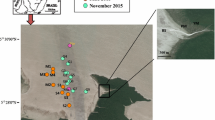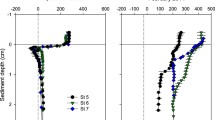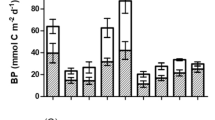Abstract
Temporal and spatial variations in benthic metabolism and anaerobic carbon oxidation pathways were assessed in an anthropogenically impacted (Mtoni) and a pristine (Ras Dege) mangrove forest in Tanzania. The objectives were (1) to evaluate how benthic metabolism is affected by organic carbon availability; (2) to determine the validity of diffusive release of CO2 as a measure benthic carbon oxidation; and (3) to assess the partitioning of anaerobic carbon pathways and factors controlling the availability of electron acceptors (e.g. oxidized iron). Microbial carbon oxidation measured as diffusive exchange of O2 and CO2 (32–67 and 28–115 mmol m−2 day−1, respectively) showed no specific temporal patterns. Low intertidal sediments at Mtoni fed by labile algal carbon of anthropogenic origin had higher diffusive CO2 release than high intertidal sediments that primarily received less reactive mangrove detritus. Diffusive release of CO2 apparently underestimated total sediment carbon oxidation due to CO2 loss from deep sediments via emission through biogenic structures (i.e. crab burrows and pneumatophores) and porewater seepage into creeks. We propose that diffusive fluxes in the present mangrove sediments are roughly equivalent to depth-integrated reactions occurring in the upper 12 cm. Anaerobic carbon oxidation was dominated by FeR irrespective of anthropogenic influence in sediments where the oxidizing effects of biogenic structures increased the Fe(III) level. More than 80% of the anaerobic carbon oxidation in Mtoni and Ras Dege sediments was due to FeR when reactive Fe(III) exceeded 30 μmol cm−3. The anthropogenic influence at Mtoni was primarily noted as up to one order of magnitude higher denitrification than at Ras Dege, but this process always accounted for less than 1% of total carbon oxidation. It is noteworthy that organic and nutrient enrichment of anthropogenic origin in Mtoni has no measurable effect on microbial processes, other than carbon oxidation in the low intertidal area and denitrification throughout the forest, and indicates a strong resilience of mangrove environments towards disturbances.









Similar content being viewed by others
References
Allaway WG, Curran M, Hollington LM, Ricketts MC, Skelton NJ (2001) Gas space and oxygen exchange in roots of Avicennia marina (Forssk.) Vierh. var. australasica (Walp.) Moldenke ex N. C. Duke, the Grey Mangrove. Wetl Ecol Manag 9:211–218
Alongi DM (1994) Zonation and seasonality of benthic primary production and community respiration in tropical mangrove forests. Oecologia 98:320–327
Alongi DM, Tirendi F, Dixon P, Trott LA, Brunskill GJ (1999) Mineralization of organic matter in intertidal sediments of a tropical semi-enclosed delta. Estuar Coast Shelf Sci 48:451–467
Alongi DM, Tirendi F, Clough BF (2000) Below-ground decomposition of organic matter in forests of the mangroves Rhizophora stylosa and Avicennia marina along the arid coast of Western Australia. Aquat Bot 68:97–122
Alongi DM, Sasekumar A, Chong CV, Pfizner J, Trott LA, Tirendi F, Dixon P, Brunskill GJ (2004) Sediment accumulation and organic material flux in a managed mangrove ecosystem: estimates of land-ocean-atmosphere exchange in peninsular Malaysia. Mar Geol 208:383–402
Alongi DM, Pfitzner J, Trott LA, Tirendi F, Dixon P, Klumpp DW (2005) Rapid sediment accumulation and microbial mineralization in forests of the mangrove Kandelia candel in the Jiulongliang Estuary, China. Estuar Coast Shelf Sci 63:605–618
Alongi DM, Trott LA, Rachmansyah, Tirendi F, McKinnon AD, Undu MC (2008) Growth and development of mangrove forests overlying smothered coral reefs, Sulawesi and Sumatra, Indonesia. Mar Ecol Prog Ser 370:97–109
Berelson WM, Johnson K, Coale K, Li HC (2002) Organic matter diagenesis in the sediments of the San Pedro Shelf along a transect affected by sewage effluent. Cont Shelf Res 22:1101–1115
Borges AV, Djenidi S, Lacroix G, Theate J, Delille B, Frankignoulle M (2003) Atmospheric CO2 flux from mangrove surrounding waters. Geophys Res Lett 30:1558. doi:10.1029/2003GL017143
Bouillon S, Dahdouh-Guebas F, Rao AVVS, Koedam N, Dehairs F (2003) Sources of organic carbon in mangrove sediments: variability and possible ecological implications. Hydrobiologia 495:33–39
Bouillon S, Middelburg JJ, Dehairs F, Borges AV, Abril G, Flindt MR, Ulomi S, Kristensen E (2007) Importance of intertidal sediment processes and porewater exchange on the water column biogeochemistry in a pristine mangrove creek (Ras Dege, Tanzania). Biogeosciences 4:311–322
Bouillon S, Borges AV, Castañeda-Moya E, Diele K, Dittmar T, Duke NC, Kristensen E, Lee SY, Marchand C, Middelburg JJ, Rivera-Monroy VH, Smith TJ III, Twilley RR (2008) Mangrove production and carbon sinks: a revision of global budget estimates. Global Biogeochem Cycles 22:GB2013. doi:10.1029/2007GB003052
Canfield DE, Thamdrup B, Hansen JW (1993) The anaerobic degradation of organic matter in Danish coastal sediments: iron reduction, manganese reduction, and sulfate reduction. Geochim Cosmochim Acta 57:3867–3883
Canfield DE, Kristensen E, Thamdrup B (2005) Aquatic geomicrobiology. Elsevier, Amsterdam
Clark MW, McConchie D, Lewis DW, Saenger P (1998) Redox stratification and heavy metal partitioning in Avicennia-dominated mangrove sediments: a geochemical model. Chem Geol 149:147–171
Corredor JE, Morell JM (1994) Nitrate depuration of secondary sewage effluents in mangrove sediments. Estuaries 17:295–300
De la Iglesia HO, Rodriquez EM, Dezi RE (1994) Burrow plugging in the crab Uca uruguayensis and its synchronization with photoperiod and tides. Physiol Behav 55:913–919
Dittmar T, Hertkorn N, Kattner G, Lara RJ (2006) Mangroves, a major source of dissolved organic carbon to the oceans. Glob Biogeochem Cycles 20:GB1012. doi:10.1029/2005GB002570
Ferreira TO, Otero XL, Vidal-Torrado P, Macías F (2007) Effects of bioturbation by root and crab activity on iron and sulfur biogeochemistry in mangrove substrate. Geoderma 142:36–46
Fossing H, Jørgensen BB (1989) Measurement of bacterial sulfate-reduction in sediments: evaluation of a single-step chromium reduction method. Biogeochemistry 8:205–222
Granek E, Ruttenberg BI (2008) Changes in biotic and abiotic processes following mangrove clearing. Estuar Coast Shelf Sci 80:555–562
Hall POJ, Aller RC (1992) Rapid, small-volume flow injection analysis for ΣCO2 and NH4 + in marine and freshwaters. Limnol Oceanogr 37:1113–1118
Holmer M, Andersen FØ, Holmboe N, Kristensen E, Thongtham N (1999) Transformation and exchange processes in the Bangrong mangrove forest-seagrass bed system, Thailand. Seasonal and spatial variations in benthic metabolism and sulfur biogeochemistry. Aquat Microb Ecol 20:203–212
Jennerjahn TC, Ittekkot V (2002) Relevance of mangroves for the production and deposition of organic matter along tropical continental margins. Naturwissenschaften 89:23–30
Jensen MM, Thamdrup B, Rysgaard S, Holmer M, Fossing H (2003) Rates and regulation of microbial iron reduction in sediments of the Baltic-North Sea transition. Biogeochemistry 65:295–317
Jørgensen BB (1978) A comparison of methods for the quantification of bacterial sulfate reduction in coastal marine sediments. Geomicrobiol J 1:11–27
Kitaya Y, Yabuki K, Kiyota M, Tani A, Hirano T, Aiga I (2002) Gas exchange and oxygen concentration in pneumatophores and prop roots of four mangrove species. Trees 16:155–158
Kostka JE, Luther GW (1994) Partitioning and speciation of solid phase iron in saltmarsh sediments. Geochim Cosmochim Acta 58:1701–1710
Kostka JE, Gribsholt B, Petrie E, Dalton D, Skelton H, Kristensen E (2002) The rates and pathways of carbon oxidation in bioturbated saltmarsh sediments. Limnol Oceanogr 47:230–240
Kristensen E (2008) Mangrove crabs as ecosystem engineers; with emphasis on sediment processes. J Sea Res 59:30–43
Kristensen E, Alongi DM (2006) Control by fiddler crabs (Uca vocans) and plant roots (Avicennia marina) on carbon, iron and sulfur biogeochemistry in mangrove sediment. Limnol Oceanogr 51:1557–1571
Kristensen E, Andersen FØ (1987) Determination of organic carbon in marine sediments: comparison of two CHN-analyzer methods. J Exp Mar Biol Ecol 109:15–23
Kristensen E, Holmer M (2001) Decomposition of plant materials in marine sediment exposed to different electron acceptors (O2, NO3 − and SO4 2−), with emphasis on substrate origin, degradation kinetics and the role of bioturbation. Geochim Cosmochim Acta 65:419–434
Kristensen E, King GM, Banta GT, Holmer M, Jensen MH, Hansen K, Bussarawit N (1994) Acetate turnover, sulfate reduction and carbon metabolism in sediments of the Ao Nam Bor mangrove, Phuket, Thailand. Mar Ecol Prog Ser 109:245–255
Kristensen E, Andersen FØ, Holmboe N, Holmer M, Thongtham N (2000) Carbon and nitrogen mineralization in sediment of the Bangrong mangrove area, Phuket, Thailand. Aquat Microb Ecol 22:199–213
Kristensen E, Bouillon S, Dittmar T, Marchand C (2008a) Organic carbon dynamics in mangrove ecosystems. Aquat Bot 89:201–219
Kristensen E, Flindt MR, Borges AV, Bouillon S (2008b) Emission of CO2 and CH4 to the atmosphere by sediments and open waters in two Tanzanian mangrove forests. Mar Ecol Prog Ser 370:53–67
Lee RY, Joye SB (2006) Seasonal patterns of nitrogen fixation and denitrification in oceanic mangrove habitats. Mar Ecol Prog Ser 307:127–141
Lovelock CE (2008) Soil respiration and belowground carbon allocation in mangrove forests. Ecosystems 11:342–354
Lovley DR, Phillips EJP (1987) Rapid assay for microbially reducible ferric iron in aquatic sediments. Appl Environ Microbiol 53:1536–1540
Marchand C, Baltzer F, Lallier-Verges E, Alberic P (2004) Pore-water chemistry in mangrove sediments: relationship with species composition and developmental stages (French Guiana). Mar Geol 208:361–381
Middelburg JJ, Nieuwenhuize J, Slim FJ, Ohowa B (1996) Sediment biogeochemistry in an East African mangrove forest (Gazi Bay, Kenya). Biogeochemistry 34:133–155
Nielsen LP (1992) Denitrification in sediment determined from isotope pairing. FEMS Microbiol Ecol 86:357–362
Nielsen OI, Kristensen E, Macintosh DJ (2003) Impact of fiddler crabs (Uca spp) on rates and pathways of benthic mineralization in deposited shrimp pond waste. J Exp Mar Biol Ecol 289:59–81
Parsons TR, Maita Y, Lalli CM (1984) A manual of chemical and biological methods for seawater analysis. Pergamon Press, Oxford
Penha-Lopes G, Bartolini F, Limbu S, Cannicci S, Kristensen E, Paula J (2009) Are fiddler crabs potentially useful ecosystem engineers in mangrove wastewater wetlands? Mar Pollut Bull 58:1694–1703
Poungparn S, Komiyama A, Tanaka A, Sangtiean T, Maknual C, Kato S, Tanapermpool P, Patanaponpaiboon P (2009) Carbon dioxide emission through soil respiration in a secondary mangrove forest of eastern Thailand. J Trop Ecol 25:393–400
Purnobasuki H, Suzuki M (2005) Aerenchyma tissue development and gas-pathway structure in root of Avicennia marina (Forsk.) Vierh. J Plant Res 118:285–294
Ridd PV (1996) Flow through animal burrows in mangrove creeks. Estuar Coast Shelf Sci 43:617–625
Rivera-Monroy VH, Twilley RR (1996) The relative role of denitrification and immobilization in the fate of inorganic nitrogen in mangrove sediments (Terminos Lagoon, Mexico). Limnol Oceanogr 41:284–296
Roden EE, Wetzel RG (2002) Kinetics of microbial Fe(III) oxide reduction in freshwater wetland sediments. Limnol Oceanogr 47:198–211
Susilo A, Ridd PV, Thomas S (2005) Comparison between tidally driven groundwater flow and flushing of animal burrows in tropical mangrove swamps. Wetl Ecol Manag 13:377–388
Acknowledgements
We are grateful for invaluable help in the field by Mads Grue and Morten S. Andersen. Our gratitude is also due to Birthe Christensen for skilful technical assistance. This research was supported by the EC-INCO programme PUMPSEA (contract 510863), The Carlsberg Foundation (contract 2005-1-325) and the Danish Research Agency (contract 09-071369).
Author information
Authors and Affiliations
Corresponding author
Rights and permissions
About this article
Cite this article
Kristensen, E., Mangion, P., Tang, M. et al. Microbial carbon oxidation rates and pathways in sediments of two Tanzanian mangrove forests. Biogeochemistry 103, 143–158 (2011). https://doi.org/10.1007/s10533-010-9453-2
Received:
Accepted:
Published:
Issue Date:
DOI: https://doi.org/10.1007/s10533-010-9453-2




